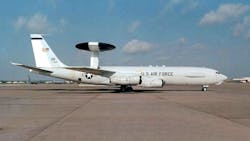U.S. Air Force Updates Saudi Arabia’s AWACS
The U.S. Air Force has awarded a $398 million form-fixed-price contract to the Boeing Company for upgrading the Royal Saudi Air Force’s Airborne Warning and Control System (AWACS) aircraft. The contract, which involves 100% Foreign Military Sales (FMS), is part of Phase 2 of the AWACS Modernization Program, to keep the RSAF E-3 AWACS fleet interoperable with the U.S. Air Force and functionally viable through expected end of life in 2040. Boeing will perform work on the RSAF’s AWACS fleet at the Air Force Life Cycle Management Center at Hanscom Air Force Base, MA. The upgrade is expected to be completed by February 21, 2026.
The E-3 AWACS (see the figure) features a look-down radar with a 360° view of the horizon and a detection range of 250 miles (375.5 km) from all altitudes. It can detect and track targets in the air and at sea simultaneously and can differentiate friendly and threat aircraft even flying at low altitudes by eliminating ground clutter returns. The AWACS is based on a modified Boeing 707/320 aircraft, designed to perform simultaneous surveillance, target detection, and target tracking. It features a large rotating radar dome antenna 30 ft. (9.1 m) in diameter.
About the Author
Jack Browne
Technical Contributor
Jack Browne, Technical Contributor, has worked in technical publishing for over 30 years. He managed the content and production of three technical journals while at the American Institute of Physics, including Medical Physics and the Journal of Vacuum Science & Technology. He has been a Publisher and Editor for Penton Media, started the firm’s Wireless Symposium & Exhibition trade show in 1993, and currently serves as Technical Contributor for that company's Microwaves & RF magazine. Browne, who holds a BS in Mathematics from City College of New York and BA degrees in English and Philosophy from Fordham University, is a member of the IEEE.
